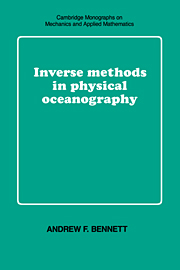Book contents
- Frontmatter
- Contents
- Preface
- 1 Finite-dimensional inverse theory
- 2 The smoothing of observations
- 3 Data assimilation
- 4 The spatial structure of the Kalman filter
- 5 Generalized inverses of dynamical models
- 6 Antenna analysis
- 7 Nonlinear quasi-geostrophic models
- 8 Open-ocean modelling: quasi-geostrophy
- 9 Primitive-equation models
- 10 Outstanding problems
- Bibliography
- Subject index
9 - Primitive-equation models
Published online by Cambridge University Press: 08 January 2010
- Frontmatter
- Contents
- Preface
- 1 Finite-dimensional inverse theory
- 2 The smoothing of observations
- 3 Data assimilation
- 4 The spatial structure of the Kalman filter
- 5 Generalized inverses of dynamical models
- 6 Antenna analysis
- 7 Nonlinear quasi-geostrophic models
- 8 Open-ocean modelling: quasi-geostrophy
- 9 Primitive-equation models
- 10 Outstanding problems
- Bibliography
- Subject index
Summary
Introduction
The quasi-geostrophic circulation models considered in Chapters 3-8 contain mechanisms of fundamental importance, such as baro-tropic instability, baroclinic instability (Pedlosky, 1987) and fronto-genesis (Stone, 1966). Nevertheless, only the more complex primitive-equation models (Lorenz, 1967) can reasonably be expected to have a close resemblance to major ocean current systems. The many assumptions underlying the simpler models do not hold in the real ocean. Consider, for example, the Antarctic Circumpolar Current system (ACC). A meridional section of the density field is shown in Fig. 9.1.1 (Patterson & Whitworth, 1990). Zonal geostrophic velocities of several tens of centimeters per second may be inferred, implying a Rossby number as small as. However, the bathymetry has changes of order unity in the meridional direction alone, as do the depths of the isopycnal surfaces. Moreover, in some of the eddies and rings associated with the ACC, the Rossby number may approach a value of 10-1 (Bryden, 1983). Thus for varying reasons it may be concluded that the horizontal field of velocity in the ACC is significantly divergent, and therefore poorly represented in the quasi-geostrophic approximation. Similar remarks may be made about the Gulf Stream (Stommel, 1960) and about the Kuroshio (Stommel & Yoshida, 1972). Equatorial ocean dynamics are fundamentally non-geostrophic, even on seasonal or even interannual time scales, owing to the significance of Kelvin waves (Philander, 1990).
- Type
- Chapter
- Information
- Inverse Methods in Physical Oceanography , pp. 257 - 282Publisher: Cambridge University PressPrint publication year: 1992



